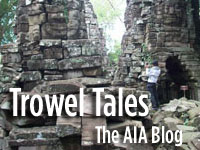Strange and Unexpected Threats
by Mark Rose
July 6, 2010
We’re all familiar with the usual perils faced by archaeological sites: commercial or residential development, inundation by a dam, looting, and so forth. But there are offbeat enemies of our ancient heritage as well. I was reminded of this when I received the July/August issue of Preservation, the magazine of the National Trust for Historic Preservation. The issue has the annual list of “America’s 11 Most Endangered Places.†The focus of this listing is usually on historic structures, but from time to time includes archaeological sites. This year, Pagat, an ancient site on the north coast of Guam appears in the list. A village of the indigenous Chamorro people, it has more than 50 middens and some 20 sets of lattes—limestone pillars crowned with capstones that supported wood and thatch buildings. The threat? Expansion of U.S. military facilities as 8,600 marines and 9,000 dependents are moved from Okinawa to Guam. Think housing, piers, bombing range…
Sites listed by the National Trust before have included the Camino Real de Tierra Adentro, the earliest Euro-American trade route in New Mexico and Texas, and Minidoka National Historic Site, a WWII-era Japanese-American internment camp in Idaho (see our interview “Bringing Dark Times to Lightâ€). The Camino Real was threatened by development of a commercial spaceport, while Minidoka was faced with construction of a feedlot for 13,000 cattle 1.25 miles upwind!
Earlier this year, the Civil War Preservation Trust announced its own list of 10 “endangered†sites and an additional 15 that are “at risk†in its annual “History Under Siege.” Threats to the sites on the list, primarily battlefields, were all over the map. Again, there were the usual suspects, but there were also several examples of viewshed desecration, from wind turbines and cell towers to a 350-tall smokestack. Then there were the real oddballs: church expansion at Fort Stevens in Washington, D.C., a casino at Gettysburg, and, my favorite, construction of a “sorority village†atop Fort Sanders at the University of Tennessee (see my earlier blog entry “Sororities vs. Civil War.”)
For the past two years, 2008 and 2009, we have included in our January/February issue a symbolic group of archaeological Sites Under Threat from around the world facing a variety of threats. One site on our lists, Guoy Cave in France, is under attack by thousands of tree rootlets that are encroaching on Upper Paleolithic paintings in the cave’s entrance chamber.
The point here is that even “green†projects like wind farms can adversely affect archaeological and historical sites. Respected institutions, from churches to universities, can clash with the past. And keep an eye on those trees—they’ll sneak up on you. Our Sites Under Threat for 2010 is growing. The “bad guys†will include the regulars, like the Tigris River devouring the 4,500-year-old city of Assur, but undoubtedly there will be some odd adversaries as well.
Comments posted here do not represent the views or policies of the Archaeological Institute of America.







 Heather Pringle is a freelance science journalist who has been writing about archaeology for more than 20 years. She is the author of Master Plan: Himmler's Scholars and the Holocaust and The Mummy Congress: Science, Obsession, and the Everlasting Dead. For more about Heather, see our
Heather Pringle is a freelance science journalist who has been writing about archaeology for more than 20 years. She is the author of Master Plan: Himmler's Scholars and the Holocaust and The Mummy Congress: Science, Obsession, and the Everlasting Dead. For more about Heather, see our 



